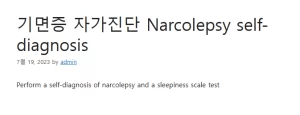Perform a self-diagnosis of narcolepsy and a sleepiness scale test
Narcolepsy is a sleep disorder caused by abnormal secretion of hormones that control drowsiness and wakefulness in the hypothalamus of the brain.
As a result, you may fall asleep unknowingly or, on the contrary, become overly aroused and unable to sleep.
However, since drowsiness appears and disappears for many reasons, simply having a lot of drowsiness cannot be dismissed as narcolepsy. 기면증 자가진단
So, when narcolepsy is suspected, self-diagnosis to check the scale of drowsiness is essential. 좋은뉴스

What is the Daytime Sleepiness Scale Test?
The daytime sleepiness scale test is a self-diagnosis method for narcolepsy that can objectively measure the degree of sleepiness during the day.
Today’s test is the Abworth Sleepiness Scale (ESS score).
It is a questionnaire frequently used when diagnosing narcolepsy patients at actual sleep clinics, and it is also the standard of reimbursement for patients with suspected narcolepsy to be covered by health insurance for polysomnography.
<Inspection method>
Calculate the total score after scoring a moderate number of points on how easily one falls asleep or falls asleep in the following situations.
However, based on your recent daily life, you should answer that you are drowsy or asleep, not simply feeling tired.
*look
0 points = no sleep at all
1 point = slight fear of drowsiness
2 points = moderate drowsiness
3 points = very likely to fall asleep
<Status>
1. When you sit and read a book
2. When watching TV
3. When sitting still in a public place (theater, meeting room, etc.)
4. When you drive for an hour without stopping as a passenger
5. When you have time in the afternoon to lie down to rest
6. If you are sitting and having a conversation with someone
7. Having lunch without alcohol and sitting quietly
8. In a car, while driving and stopped for a few minutes in a traffic jam
In each of the situations presented above, when the degree of sleepiness is selected and scored by oneself, if the total score exceeds 8 points, pathological daytime sleepiness is presumed.
If you are confused about self-diagnosis of narcolepsy, such as the Abworth Somnolence Scale test, you may suspect narcolepsy as a normal symptom.
Suspicious symptoms that are often found include drowsiness that gets worse when you are concentrating, frequent scissors, cataplexy, dreaming even after sleeping for a short time, insomnia symptoms, and hallucinations before and after waking up.
Narcolepsy test and treatment method
If you want to get a more accurate diagnosis than self-diagnosis of narcolepsy, you should visit a sleep clinic.
The sleep clinic diagnoses symptoms of sleep disorders by conducting polysomnography and multiple sleep latency tests, and prescribes medications based on the test results.
Therefore, patients are not simply prescribed a wake-up drug, but can be prescribed a treatment suitable for their sleep pattern and symptoms of sleep disorder.
However, behavioral therapy must be combined with treatment.
Behavioral therapy is to refrain from habits that aggravate symptoms and relieve drowsiness through minor efforts.
Habits that aggravate symptoms include sleeping less than 6 hours a day, drinking or smoking before bedtime, consuming caffeine, eating spicy foods late at night, and exercising vigorously at night.
These can cause insomnia or reduce sleep quality, while at the same time exacerbating daytime sleepiness. Therefore, it is recommended to avoid it as much as possible during treatment.
There are also habits that can help relieve symptoms.
Set a schedule for going to bed and wake up, and when you are too sleepy, take a nap once or twice a day for around 15 minutes.
The habit of going to bed and waking up at a set time makes you feel less tired by having a normal sleep cycle, and a little nap helps relieve narcolepsy drowsiness.
However, if you have symptoms of narcolepsy, drug therapy and behavioral therapy must be implemented together.
If you practice only one of the two, the treatment effect may be halved or even worse.
If you have many suspicious symptoms in the self-diagnosis of narcolepsy, please visit the Breath Sleep Clinic to receive an accurate diagnosis.
Online consultation (application)
Telephone consultation (reservation)